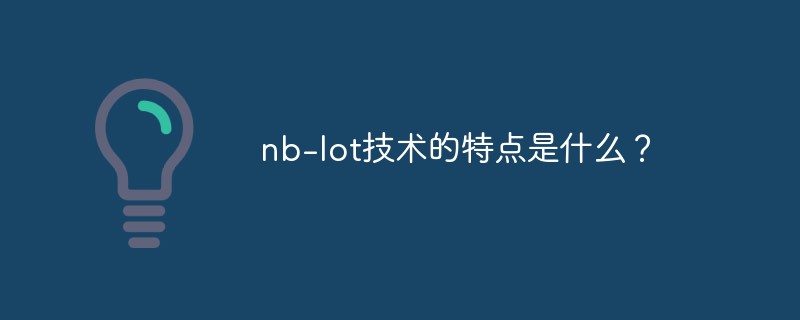What are the characteristics of nb-lot technology?
NB-IoT is an emerging technology for cellular-based narrowband Internet of Things in the IoT field. Its main features are: 1. Wide coverage, which can achieve 20db higher coverage gain than GSM; 2. Many connections, each The community can reach 100,000 connections; 3. Low speed; 4. Low cost; 5. Low power consumption; 6. Excellent architecture; 7. Stable and reliable; 8. High security.

NB-IoT (Narrow Band Internet of Things, NB-IoT) is an emerging technology for cellular-based narrowband Internet of Things in the IoT field, supporting low-power A cellular data connection that consumes devices over a wide area network, also known as Low Power Wide Area Network (LPWA). NB-IoT only consumes about 180KHz frequency band and can be directly deployed on GSM network, UMTS network or LTE network to support efficient connection of devices with short standby time and high network connection requirements.
Its main features are: Wide coverage, many connections, low speed, low cost, low power consumption, excellent architecture, stability and reliability, high security, etc.
NB-IOT uses License frequency bands and can be deployed in three ways: in-band, guard band or independent carrier.
NB-IoT technical advantages
1. Massive connections: each cell can reach 100,000 connections; NB-IoT is 50-100 times more powerful than 2G/3G/4G The uplink capacity is increased, which means that with the same base station, NB-IoT can provide 50 to 100 times the number of accesses than existing wireless technologies.
2. Ultra-low power consumption: battery life is up to ten years;
The energy consumed by communication equipment is often related to the amount or rate of data, that is, the size of the data packets sent per unit time determines The amount of power consumption. The data volume is small, and the device's modem and amplifier can be adjusted to very small levels. NB-IoT focuses on small data volume and low-speed applications, so the power consumption of NB-IoT equipment can be very small, which can ensure the battery life of more than 5 years.
3. Deep coverage: It can achieve 20db higher coverage gain than GSM;
NB-IoT has a 20dB gain higher than LTE, which is equivalent to a 100-fold increase in transmit power, that is, the coverage capability has been improved 100 times, it can cover even in underground garages, basements, underground pipes and other places where signals are difficult to reach.
4. Stable and reliable: It can provide carrier-grade reliable access and effectively support IoT applications and smart city solutions.
NB- IoT is directly deployed on GSM network, UMTS network or LTE network, and can be reused with existing network base stations to reduce deployment costs and achieve smooth upgrades. However, it uses a separate 180KHz frequency band and does not occupy existing network base stations. The network's voice and data bandwidth ensures that traditional services and future IoT services can be carried out stably and reliably at the same time. Taking smart meter reading applications as an example, compared with the data recovery success rate of wired PLC meter reading, which is about 60%, NB-IoT can ensure a data recovery rate of 99%, greatly improving reliability.
5. Security: Inheriting 4G network security capabilities, supporting two-way authentication and strict air interface encryption to ensure the security of user data;
The above is the detailed content of What are the characteristics of nb-lot technology?. For more information, please follow other related articles on the PHP Chinese website!

Hot AI Tools

Undresser.AI Undress
AI-powered app for creating realistic nude photos

AI Clothes Remover
Online AI tool for removing clothes from photos.

Undress AI Tool
Undress images for free

Clothoff.io
AI clothes remover

AI Hentai Generator
Generate AI Hentai for free.

Hot Article

Hot Tools

Notepad++7.3.1
Easy-to-use and free code editor

SublimeText3 Chinese version
Chinese version, very easy to use

Zend Studio 13.0.1
Powerful PHP integrated development environment

Dreamweaver CS6
Visual web development tools

SublimeText3 Mac version
God-level code editing software (SublimeText3)

Hot Topics
 1377
1377
 52
52


